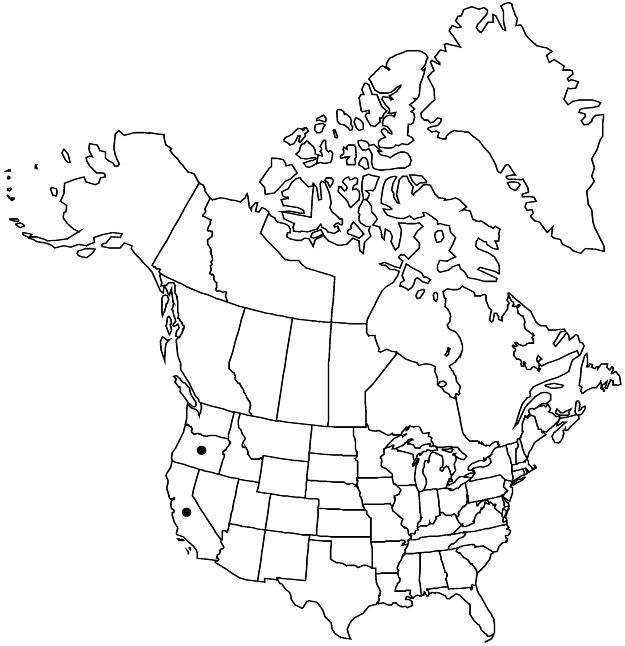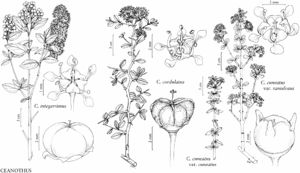Difference between revisions of "Ceanothus cuneatus var. cuneatus"
FNA>Volume Importer |
FNA>Volume Importer |
||
| Line 30: | Line 30: | ||
|elevation=10–1900 m. | |elevation=10–1900 m. | ||
|distribution=Calif.;Oreg.;Mexico (Baja California). | |distribution=Calif.;Oreg.;Mexico (Baja California). | ||
| − | |discussion=<p>Variety cuneatus in Oregon and in the Klamath Mountains of northern California is characterized by relatively small, elliptic to oblanceolate leaf blades 6–12 millimeters. The type specimen, collected by David Douglas in the upper Willamette Valley of Oregon, falls within this range. Low-growing, moundlike plants in the Klamath Mountains, less than eight tenths of a meter, with spreading stems, leaves similar in size and shape, and white to pale blue sepals and petals, are treated here as <i>Ceanothus arcuatus</i>. Elsewhere, <i></i>var.<i> cuneatus</i> is characterized by leaf blades 9–30 millimeters.</p><!-- | + | |discussion=<p>Variety cuneatus in Oregon and in the Klamath Mountains of northern California is characterized by relatively small, elliptic to oblanceolate leaf blades 6–12 millimeters. The type specimen, collected by David Douglas in the upper Willamette Valley of Oregon, falls within this range. Low-growing, moundlike plants in the Klamath Mountains, less than eight tenths of a meter, with spreading stems, leaves similar in size and shape, and white to pale blue sepals and petals, are treated here as <i>Ceanothus arcuatus</i>. Elsewhere, <i></i></i>var.<i><i> cuneatus</i> is characterized by leaf blades 9–30 millimeters.</p><!-- |
| − | --><p>Shrubs to 3.5 meters with large leaf blades 15–30 × 9–18(–22) millimeters have been named <i>Ceanothus cuneatus</i> var. dubius J. T. Howell, and are restricted to sandy soils and open sites in chaparral and mixed evergreen forests of the Santa Cruz Mountains. Plants in the Transverse and Peninsular ranges of southern California, with narrowly oblanceolate leaf blades with sparsely canescent abaxial surfaces, have been named C. oblanceolatus Davidson. Putative hybrids with <i>C. pauciflorus</i> have been reported from several localities in the southern Sierra <i>Nevada</i> (H. McMinn 1944). Formally named hybrids involving <i></i>var.<i> cuneatus</i> include C. ×connivens Greene (either with <i>C. prostratus</i> or <i>C. fresnensis</i>), C. ×flexilis McMinn (with <i>C. prostratus</i>), and C. ×humboldtensis Roof (with <i>C. pumilus</i>).</p><!-- | + | --><p>Shrubs to 3.5 meters with large leaf blades 15–30 × 9–18(–22) millimeters have been named <i>Ceanothus cuneatus</i> var. dubius J. T. Howell, and are restricted to sandy soils and open sites in chaparral and mixed evergreen forests of the Santa Cruz Mountains. Plants in the Transverse and Peninsular ranges of southern California, with narrowly oblanceolate leaf blades with sparsely canescent abaxial surfaces, have been named C. oblanceolatus Davidson. Putative hybrids with <i>C. pauciflorus</i> have been reported from several localities in the southern Sierra <i>Nevada</i> (H. McMinn 1944). Formally named hybrids involving <i></i></i>var.<i><i> cuneatus</i> include C. ×connivens Greene (either with <i>C. prostratus</i> or <i>C. fresnensis</i>), C. ×flexilis McMinn (with <i>C. prostratus</i>), and C. ×humboldtensis Roof (with <i>C. pumilus</i>).</p><!-- |
| − | --><p>Wood of <i></i>var.<i> cuneatus</i> was used by Native Americans to make tools and arrow foreshafts (D. E. Moerman 1998).</p> | + | --><p>Wood of <i></i></i>var.<i><i> cuneatus</i> was used by Native Americans to make tools and arrow foreshafts (D. E. Moerman 1998).</p> |
|tables= | |tables= | ||
|references= | |references= | ||
| Line 56: | Line 56: | ||
|publication year= | |publication year= | ||
|special status=Selected by author to be illustrated | |special status=Selected by author to be illustrated | ||
| − | |source xml=https://jpend@bitbucket.org/aafc-mbb/fna-data-curation.git/src/ | + | |source xml=https://jpend@bitbucket.org/aafc-mbb/fna-data-curation.git/src/f6b125a955440c0872999024f038d74684f65921/coarse_grained_fna_xml/V12/V12_98.xml |
|genus=Ceanothus | |genus=Ceanothus | ||
|subgenus=Ceanothus subg. Cerastes | |subgenus=Ceanothus subg. Cerastes | ||
Revision as of 19:22, 24 September 2019
Shrubs, 1.5–3.5 m. Stems erect; branchlets grayish brown to light gray, glaucous. Leaf blades of fascicled and non-fascicled leaves flat, elliptic to widely oblanceolate, 6–22(–30) × 3–12(–22) mm, length usually 2+ times width, margins entire, apex usually obtuse to rounded, rarely truncate. Flowers: sepals, petals, and nectary usually white, sometimes pale blue or pale lavender. Capsules 4–6 mm wide. 2n = 24.
Phenology: Flowering Jan–May.
Habitat: Rocky slopes, ridges, sometimes on serpentine, chaparral, oak and oak-pine woodlands, conifer forests, gravelly floodplains.
Elevation: 10–1900 m.
Distribution

Calif., Oreg., Mexico (Baja California).
Discussion
Variety cuneatus in Oregon and in the Klamath Mountains of northern California is characterized by relatively small, elliptic to oblanceolate leaf blades 6–12 millimeters. The type specimen, collected by David Douglas in the upper Willamette Valley of Oregon, falls within this range. Low-growing, moundlike plants in the Klamath Mountains, less than eight tenths of a meter, with spreading stems, leaves similar in size and shape, and white to pale blue sepals and petals, are treated here as Ceanothus arcuatus. Elsewhere, var. cuneatus is characterized by leaf blades 9–30 millimeters.
Shrubs to 3.5 meters with large leaf blades 15–30 × 9–18(–22) millimeters have been named Ceanothus cuneatus var. dubius J. T. Howell, and are restricted to sandy soils and open sites in chaparral and mixed evergreen forests of the Santa Cruz Mountains. Plants in the Transverse and Peninsular ranges of southern California, with narrowly oblanceolate leaf blades with sparsely canescent abaxial surfaces, have been named C. oblanceolatus Davidson. Putative hybrids with C. pauciflorus have been reported from several localities in the southern Sierra Nevada (H. McMinn 1944). Formally named hybrids involving var. cuneatus include C. ×connivens Greene (either with C. prostratus or C. fresnensis), C. ×flexilis McMinn (with C. prostratus), and C. ×humboldtensis Roof (with C. pumilus).
Wood of var. cuneatus was used by Native Americans to make tools and arrow foreshafts (D. E. Moerman 1998).
Selected References
None.
